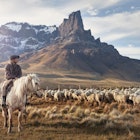

Is Instagram's impact on travel good? © Rosie Bell / Lonely Planet
It’s hard to remember a time when the ‘Gram wasn’t a part of our lives. As a full-time travel writer, I’m regularly confronted with Instagram’s omnipresence, from dealings with hospitality businesses to people asking if I’m an IG influencer (I’m not). “So how are you a travel writer then?” is often the next question. Instagram has infiltrated the very core of travel; how people interact with places, where they choose to go and the art of telling travel tales. Over the last decade, Instagram has helped build our travel dreams, but has it destroyed them too?

The crux of misbehaving influencers
With over a billion monthly users, Instagram has become a crowded market for existing (and wannabe) influencers. This oversaturation is pushing people to up the ante in the bizarreness (and danger) stakes to garner attention and go viral. To get those to-die-for shots (literally), daredevils are living on the edge of cliffs, trespassing, rooftopping, smooching leaning out of moving trains, perching on train tracks and taking volcano selfies resulting in a number of fatalities. Between 2011 and 2017, there were over 250 selfie-related deaths.
The list of bad influencer etiquette includes engaging in coitus at the Giza Pyramids, posting photos with underprivileged children while publicizing their HIV status, playful selfies at Auschwitz, eating endangered wildlife, anti-capitalist “begpacking” under the guise of crowdfunding.
Related content: This is Vietnam’s latest dangerous train-selfie spot
Staged reality
On Instagram, desert safaris, cave visits and deep-sea dives are activities that may be carried out wearing evening gowns. Disingenuous photo setups like excessively large food servings on floating baskets make great photo compositions but they aren’t representative of how most people really travel and essentially encourage food wastage.
Hordes of visitors to Bali’s Lempuyang temple (#gatesofheaven) were appalled to discover that a “lake” they’d seen in countless influencer images was actually an optical illusion created by placing a mirror underneath an iPhone.
As someone who makes a living as a travel writer, perhaps I’m in no position to disparage others who do the same. The problem with Instagram’s travel narrative, however, is this propensity to extend truths: hyper-editing, brighter colors, erased tourists and even the addition of fake birds. There’s no definitive rulebook for Instagram influencers yet, which means images may not be factual representations and as such, we can’t always believe what we see.

Overtourism
As a holiday planning tool, Instagram is marvelous. Geotagging means desirable sites can be identified and saved in folders, like curating one’s own holiday brochure. Reports show that Instagram is part of travelers’ decision-making process with people choosing locations based on potential likes. It has catapulted places like Cappadocia, Horseshoe Bend and Norway’s Trolltunga to destination celebrities.
However, there’s an undeniable issue of overtourism with hotspots whose Insta-fame becomes untenable, sometimes leading to indefinite closure like the Sunflower farm in Ontario.
Santorini has capped daily visitor numbers and Boracay in the Philippines closed for six months to recover from the effects of overtourism. To manage environmental degradation, Jackson Hole in Wyoming has asked visitors to stop geotagging photos altogether.
Made-for-IG experiences
Another impact Instagram has had on the travel industry is the emergence of selfie factories. The world’s galleries must now grapple Instagram museums which are specifically social media traps; think the Museum of Ice Cream and Color Factory which both now have outposts in multiple US cities. Where traditional galleries have historically banned photography, these interactive, color-bursting venues thrive on photo ops. Cafes and restaurants too are increasingly Instagram-focused in their décor and menus.

New job roles
To cater to our Insta-obsession, novel professions have cropped up like Royal Caribbean’s Instagrammer-in-Chief role. Instagram Butler is now a real job at the Conrad Maldives Rangali Island and hotel chain Ibis trialed a service of Instagram Sitters who’d manage guests' accounts during their stay so they could be fully present and actually enjoy themselves.
Hyper-documentation
“Pics or it didn’t happen,” right? The urge to document experiences means we’re always switched on and in search of #instabrag moments. We wish to see the world but increasingly do so via filters and stories. While some businesses actively encourage this penchant for self-expression, others are trying to save us from ourselves. Wyndham Grand rewards guests that are willing to lock up their phones with free food and prime poolside spots. Disconnecting to reconnect is their prescription.
At the end of the day, we may choose to view Instagram as what it is – a series of squares. However, it’s undeniable they’re shaping how we see the world.
Explore related stories

Photography
From Acadia to Zion: A complete guide to all 63 national parks in the United StatesMar 4, 2022 • 24 min read









